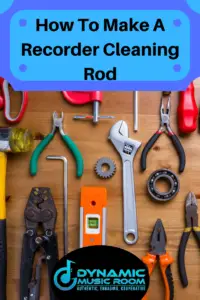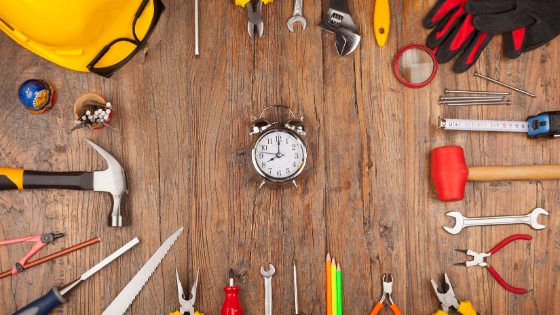Are your students constantly losing their cleaning rods and you don’t want to keep replacing them?
I was in the same boat, so I did some research and found out how to make a recorder cleaning rod.
Making your own recorder cleaning rod is simple if you know how to do it. Basically, you trim down a plastic coat hanger to fit the length of your recorder and notch in a hole for the cleaning cloth to fit into.
Read the rest of this article for more detailed instructions.
Table of Contents
What You’ll Need
Look at these items for what you need to get this done. You may have all of these around the house already, but if you don’t, I’ll include links to example products so you know what to look for.
Thin Plastic Hangers – The bottom of the plastic hanger will form the main part of the rod of your homemade product. Check to make sure the thickness will fit inside the recorder’s body with room for fabric.
I have a ton of small hangers for my young kids, and I find this works well.
As an alternative, a wire hanger or just plain strong wire will do. However, this may scratch the inside of your recorder if you’re not careful.
Pruning Shears – You need something to cut the hanger apart. Pruning shears work well, as do tin snips. A box cutter will also do the job, though it requires a little more work.
Box Cutter – A box cutter is a common tool you probably already have around the house. For this project, the knife can cut the hanger apart, and it’s essential for carving out the hole for the fabric to go into.
Electrical Tape – You may be able to get away with electrical tape if you want to melt the ends of the cut hanger to soften the ends. I like using electrical tape because it’ll easily secure and protect the rod and recorder.
Related Reading: Learn about the best recorder brands.

Step-By-Step Instructions For How To Make A Recorder Cleaning Rod
Follow these directions closely, and you’ll find making your own rod isn’t hard to do at all. This rod is also useful for other instruments such as the flute as well.
#1 Check The Thickness
There’s a saying in the builder’s world: “Measure twice. Cut once.”
This saying applies to any project, really. For this one, you should double-check the thickness of the hanger by holding it up to the recorder.
The length of the rod should be an inch or two longer than the length of the recorder’s body. Its thickness should allow for the rod and a thin fabric to fit inside the body.
If the thickness and length work, proceed to the next step. If not, go look for a new rod replacement.
#2 Cut The Hanger
After eyeballing the length of the rod compared to the recorder, it’s time to cut. If you’re using scissors/pruning shears/snips, the cut is easy.
But for those using a box cutter, you need to take a little extra care.
Don’t pull the blade towards you and make sure your fingers are out from under the hanger where you’re cutting.
Placing the hanger on the counter or table and pressing down won’t work.
Place the hanger on a cutting board or work surface. Put your knife/box cutter against the hanger and push, but as you push, pull the knife down in a slicing motion.
After several repetitions (you’ll need to use pressure), the end will cut.
#3 Cut One End
With the rod cut out, it’s time to prepare to notch one end for the fabric to go into. This step may be skipped if you plan on just using the rod to push the fabric in the recorder (just go to step #5).
For those who want a closer cleaning rod replacement, do this step.
One end of the rod, use your box cutter to slice the material longways about 2-3 inches (7.62 cm) down the rod.
Stay as close to the middle of the rod as possible or you may end up cutting the rod apart, and then you’ll have to start all over.
#4 Carve Out The Notch
At the bottom of this cut and up 1/2-3/4 inches, shave some material off either side of the interior of the hanger rod.
This creates some space to insert the fabric once the ends have been taped up. Take care not to press too hard or you’ll break or bend the hanger.
#5 Tape The Ends
Finally, tape the ends of the rod to cover the sharper cut edges. Some people will instead use a lighter to melt the ends into a rounder shape.
Make sure you don’t tape over the fabric notch you created in the cut end. I usually tape both ends just in case I also use it upside down.
To get creative, cover the whole thing in electrical tape or colored tape for a fancier look.
Congrats! You’ve now made your own recorder cleaning rod!
If you’re more of a visual learner, check out this video:
Check out more about the 5 types of recorders.
Commonly Asked Questions
Here are some questions I’m often asked in relation to recorder cleaning rods.
How do you sanitize a recorder? – Sanitize a recorder by either washing in warm, soapy water with antibacterial dish soap, washing it in the top rack of your dishwasher, or by using a mouthpiece disinfectant spray such as the Sterisol cleaner.
How do you use a flute cleaning rod? – Take a long (same as the rod) and thin (about 1 inch (2.54 cm)) piece of fabric and stick one end through the hole in the cleaning rod. Wrap the fabric around the length of the rod.
Stick the rod in the bottom of the rod, and then pull it up while twisting the rod to rub against every surface.
Don’t push the rod in too hard or you may crack the recorder.
Can you wash a recorder? – Yes! I find the best way to wash a recorder is to let it soak in warm, soapy water using antibacterial dish soap.
After it soaks for 5 minutes, I rub it down and rinse it off.
Can you put a recorder in the dishwasher? – Yes, but you need to be careful. If you’re able to, reduce the heat on the dishwasher and/or make sure you put the recorder on the top rack of the dishwasher.
Make sure the dishes you also put in there don’t have large pieces of food. These may get stuck in the recorder during the washing process.
Check out our teaching recorder to elementary students guide.
Conclusion
Now you know how to make a recorder cleaning rod. I hope you give it a shot; your students may find it cool.
You may even want to teach them how to do it themselves (so they don’t keep bugging you about it).
If you do try it, let us know how the process went for you in the comments below.

